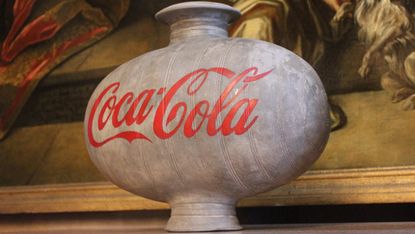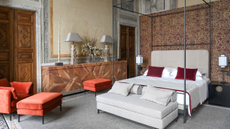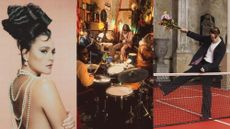Ai Weiwei at Blenheim Palace – reviews of 'dizzying' art show
Cultures and values collide in 'magical feast of images' by China's eloquent artist-activist

What you need to know
A new exhibition by contemporary dissident Chinese artist Ai Weiwei has opened at Blenheim Palace, Oxfordshire. Ai Weiwei at Blenheim Palace features over 50 new and well-known artworks by the activist-artist who lives under house arrest in China.
The show presents works spanning Ai Weiwei's career displayed throughout the palace and its grounds. It includes photographs taken by Ai in 1980s New York, the Circle of Animals/Zodiac Heads (a series of golden sculptures referring to icons of imperial China), a table made of reclaimed wood from Qing Dynasty temples and a carpet made specifically for the show. Runs until 14 December.
Subscribe to The Week
Escape your echo chamber. Get the facts behind the news, plus analysis from multiple perspectives.

Sign up for The Week's Free Newsletters
From our morning news briefing to a weekly Good News Newsletter, get the best of The Week delivered directly to your inbox.
From our morning news briefing to a weekly Good News Newsletter, get the best of The Week delivered directly to your inbox.
What the critics like
An exhibition of Ai Weiwei, the world's most celebrated, original artist-social activist, at Blenheim Palace is "a dizzying convergence of values and world views", says Jackie Wullschlager in the Financial Times. As a setting for Ai's works referring to China's cultural relations with antiquity, Blenheim adds nuance and the sheer oddness of Chinese history illuminated here underlines the ambivalence, conceptual dexterity and wrong-footing energy of Ai's vision.
This clever, fun exhibition combines old with new, "East with West, and good taste with bling, in such a subtle way that it is almost seamless", says Florence Waters in the Daily Telegraph. Ai is the perfect choice to show at an intimidating venue such as Blenheim because he's never been afraid of taking on the powerful.
Modern chinoiserie and myths of east and west meet in "a chaotic, hilarious, liberating vision of history gone mad", says Jonathan Jones in The Guardian. This magical feast of images and ideas reveals him purely as an artist - a great one.
What they don't like
While "hardly his most fascinating", famous or striking works, this show makes an impact by contrasting the eloquent simplicity of Ai's pieces with the overdone baroque grandeur of the setting, says Rachel Campbell-Johnston in The Times. Yet it "feels understated almost to the point of reticence" and will leave those being introduced to the artist longing for a deeper acquaintance.
Create an account with the same email registered to your subscription to unlock access.
Sign up for Today's Best Articles in your inbox
A free daily email with the biggest news stories of the day – and the best features from TheWeek.com
-
 'Biden is smart to keep the border-security pressure on'
'Biden is smart to keep the border-security pressure on'Instant Opinion Opinion, comment and editorials of the day
By Harold Maass, The Week US Published
-
 Bird flu worries mount as virus found in milk, cows
Bird flu worries mount as virus found in milk, cowsSpeed Read The FDA found traces of the virus in pasteurized grocery store milk
By Peter Weber, The Week US Published
-
 Palazzo Durazzo Suites in Genoa: a palatial gem in northern Italy
Palazzo Durazzo Suites in Genoa: a palatial gem in northern ItalyThe Week Recommends Live your Italian dream in this astonishing and recently restored palace in the heart of the city
By Nick Hendry Published
-
 The Westbury Hotel review: stunning suites in charming Dublin
The Westbury Hotel review: stunning suites in charming DublinThe Week Recommends This hotel is the perfect spot to while away a weekend in Ireland's capital
By Kaye O'Doherty Published
-
 Drama movies 2024: new films out this year
Drama movies 2024: new films out this yearIn Depth Latest reviews include The Boys in the Boat, One Life and Tchaikovsky's Wife
By The Week UK Last updated
-
 Best new hotels and places to stay in 2024
Best new hotels and places to stay in 2024The Week Recommends Featuring stylish island resorts, historical properties and wilderness retreats
By The Week UK Last updated
-
 Albums of the year: best music of 2023
Albums of the year: best music of 2023The Week Recommends A look back at the best pop, rap, jazz, dance, classical and rock releases
By The Week UK Published
-
 Savoy Grill by Gordon Ramsay review: an institution reinvented
Savoy Grill by Gordon Ramsay review: an institution reinventedThe Week Recommends Traditions are maintained and the tweaks are clever and modern
By Neil Davey Published
-
 Tulum: a Mexican beach town of 'two halves'
Tulum: a Mexican beach town of 'two halves'The Week Recommends With the 'pueblo' and 'Zona Hotelera', Tulum is home to great hotels, restaurants and beach clubs
By William Leigh Published
-
 La Zebra review: beach chic, perfect tacos and secret cenotes
La Zebra review: beach chic, perfect tacos and secret cenotesThe Week Recommends Enjoy a stylish stay in Mexico at this family-friendly beach hotel and restaurant
By William Leigh Published
-
 Atlantis Paradise Island Bahamas review: a mythical beachside resort
Atlantis Paradise Island Bahamas review: a mythical beachside resortThe Week Recommends Combine the classically simple pleasures of sun, sea and sand with upmarket fun and food
By Adrienne Wyper Published